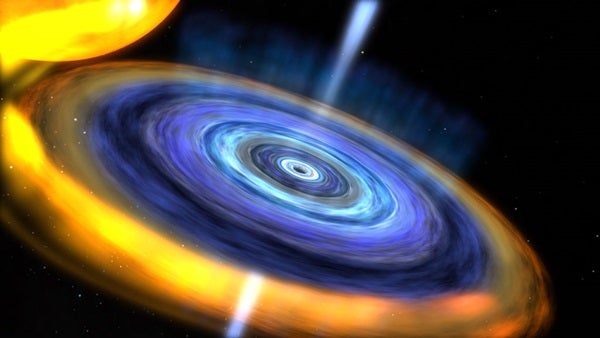Named IGR J17091-3624 after the astronomical coordinates of its sky position, the binary system combines a normal star with a black hole that may weigh less than three times the Sun’s mass. That is near the theoretical mass boundary where black holes become possible.
Gas from the normal star streams toward the black hole and forms a disk around it. Friction within the disk heats the gas to millions of degrees, which is hot enough to emit X-rays. Cyclical variations in the intensity of the X-rays observed reflect processes taking place within the gas disk. Scientists think that the most rapid changes occur near the black hole’s event horizon, the point beyond which nothing, not even light, can escape.
Astronomers first became aware of the binary system during an outburst in 2003. Archival data from various space missions show it becomes active every few years. Its most recent outburst started in February and is ongoing. The system is located in the direction of the constellation Scorpius, but its distance is not well established. It could be as close as 16,000 light-years or more than 65,000 light-years away.
The record-holder for wide-ranging X-ray variability is another black hole binary system named GRS 1915+105. This system is unique in displaying more than a dozen highly structured patterns, typically lasting between seconds and hours.
“We think that most of these patterns represent cycles of accumulation and ejection in an unstable disk, and we now see seven of them in IGR J17091,” said Tomaso Belloni from Brera Observatory in Merate, Italy. “Identifying these signatures in a second black hole system is very exciting.”
In GRS 1915, strong magnetic fields near the black hole’s event horizon eject some of the gas into dual, oppositely directed jets that blast outward at about 98 percent the speed of light. The peak of its heartbeat emission corresponds to the emergence of the jet.
Changes in the X-ray spectrum observed by RXTE during each beat reveal that the innermost region of the disk emits enough radiation to push back the gas, creating a strong outward wind that stops the inward flow, briefly starving the black hole and shutting down the jet. This corresponds to the faintest emission. Eventually, the inner disk gets so bright and hot that it essentially disintegrates and plunges toward the black hole, re-establishing the jet and beginning the cycle anew. This entire process happens in as little as 40 seconds.
While there is no direct evidence IGR J17091 possesses a particle jet, its heartbeat signature suggests that similar processes are at work. Researchers say this system’s heartbeat emission can be 20 times fainter than GRS 1915 and can cycle about eight times faster in as little as five seconds.
Astronomers estimate that GRS 1915 is about 14 times the Sun’s mass, placing it among the most-massive-known black holes that have formed because of the collapse of a single star. The research team analyzed six months of RXTE observations to compare the two systems, concluding that IGR J17091 must possess a minuscule black hole.
“Just as the heart rate of a mouse is faster than an elephant’s, the heartbeat signals from these black holes scale according to their masses,” said Diego Altamirano from the University of Amsterdam in the Netherlands.
The researchers say this analysis is just the start of a larger program to compare both of these black holes in detail using data from RXTE, NASA’s Swift satellite, and the European XMM-Newton observatory.
“Until this study, GRS 1915 was essentially a one-off, and there’s only so much we can understand from a single example,” said Tod Strohmayer from NASA’s Goddard Space Flight Center in Greenbelt, Maryland. “Now, with a second system exhibiting similar types of variability, we really can begin to test how well we understand what happens at the brink of a black hole.”










